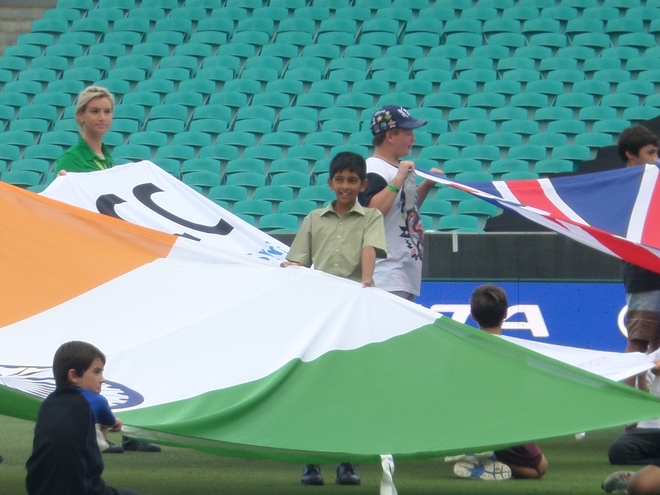
Children carrying flags during the rehearsal of the flag ceremony in Sydney on Wednesday
Rohit Mahajan in sydney
The flags of their fathers have an irresistible appeal for the children of the migrants.
Akshay Prasan, 11, has decided to learn the national anthem — the Indian national anthem. Akshay, born and brought up in Australia, is one of the children who would be part of the flag ceremony that would immediately precede the India-Australia semifinal. He knows the Australian national anthem well. But when the Indian national anthem is played tomorrow afternoon, Akshay wants to be able to recognise the words.
Akshay was absolutely certain that he wanted to be among the six kids who would carry the Indian flag — and not the Australia or the ICC flag — to the ground before the match. At the rehearsal today, he was assigned duty on the white ICC flag. He was having none of it. “He went to the event organisers and requested to be assigned on the Indian flag,” laughs his mother Shubha, a doctor. Shubha was born in England but when she was a mere baby, her parents decided to move to Australia and make it their home. She’s Aussie, but she’s Indian, too. She and Akshay are at ease with this multiplicity.
In Melbourne, Rohan Naidu, 14, desperately wanted to bear the Indian flag into the ground before the quarterfinal against Bangladesh. He was, however, assigned to carry the Bangladesh flag. He did that even as he longed to be able to carry in the Indian flag. Rohan’s father, Kumar Naidu, was born in Australia to doctor parents who migrated to Australia in the 1960s.
Shubha and Kumar Naidu are complete Aussies. They’ve lived in Australia all their lives, and both have found much success in their country.
“My son is as much an Aussie as any boy in our neighbourhood,” says Kumar Naidu. “However, he’s aware of his Indian roots, and he’s proud of them.”
“We’re Aussies, and my boys are as Aussie as any family we know,” says Shubha.
Shubha says that when she was growing up in the 1970-80s, she was encouraged by her parents to blend in with the rest of the children. She says that her two boys are comfortable with their two identities, Australian and Indian.
She says that the Indian migrants who moved to the country in the 1960s and 1970s have assimilated very well in the Australian society. “My parents were among the few families in Sydney at that time,” she says. “And they adjusted, they formed ties and made friends with the local population. They adjusted very well.”
She says her parents didn’t have a choice because there were very few Indians around at that time. The country’s “White Australia” policy, which had favoured immigration only from European countries, and especially Great Britain, was being gradually dismantled.
“It was not completely gone, but highly qualified migrants from Asia, like my parents, were able to come in,” says Kumar Naidu.
From ancient times, the flag has had a strong significance in the context of conflict between clans or nations; in modern times, flags and national colours are used with great fervour in sport, that great substitute for warfare.
In increasingly globalised, multicultural societies, the significance of the flag has become diluted and more fluid. Thus, in Melbourne, we met Abby Mourney, who was on the Indian flag, by choice — she had her reasons. “She knew that India is a country crazy about cricket, and she wanted to hold the Indian flag because she was then going to be on TV before a massive audience,” laughed Bruce Mourney, her father.
A few days ago, Scott Styris tweeted the photograph of his little daughter with the Indian colours. He said India is her team, and that she became fond of India because she spent so much time in the swimming pools of Chennai when he played in the IPL.
The West, more liberal than the East in most things, is more accepting of multiple identities of recent migrants. This is seen in the fascinating stories of the flags of the nations at the World Cup.



























